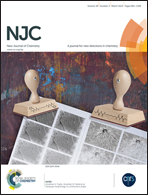V-shaped ligand bis(2-benzimidazolylmethyl)amine containing three copper(ii) ternary complexes: synthesis, structure, DNA-binding properties and antioxidant activity†
Abstract
Three copper(II) ternary complexes with the V-shaped ligand bis(2-benzimidazolylmethyl)amine (bba), with composition [Cu(bba)(crotonate)]·ClO4 (1), [Cu(bba)(methacrylate)]·ClO4 (2) and [Cu(bba)(acrylate)(CH3OH)]·NO3·H2O (3), have been synthesized and characterized by elemental analyses, molecular conductivities, IR, UV spectra and X-ray single crystal diffraction. The copper ions in these three complexes have a similar coordination mode, which can be described as a five-coordinated tetragonal pyramid geometry. The interaction of the ligand bba and copper(II) complexes with calf thymus DNA was investigated by electronic absorption, fluorescence spectroscopy and viscosity measurements. The experimental results suggest that the ligand bba and copper(II) complexes bind to DNA in an intercalation mode, and their binding affinity for DNA follows the order 2 > 1 > 3 > bba. The main reason for the DNA-binding behaviors can be attributed to the large coplanar aromatic rings in the V-shaped ligand. Such a trend in the DNA-binding affinities of the bba ligand and copper(II) complexes binding to DNA can be reasonably explained by the change of the electron density, the V-shaped angle (αV) and the value of τ. Moreover, the antioxidant assay in vitro also shows that the copper(II) complexes possess significant antioxidant activities.


 Please wait while we load your content...
Please wait while we load your content...